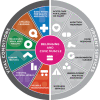Cities as Platforms for Population Health: Past, Present, and Future
- PMID: 37096598
- PMCID: PMC10126988
- DOI: 10.1111/1468-0009.12612
Cities as Platforms for Population Health: Past, Present, and Future
Abstract
Policy Points Cities have long driven innovation in public health in response to shifting trends in the burden of disease for populations. Today, the challenges facing municipal health departments include the persistent prevalence of chronic disease and deeply entrenched health inequities, as well as the evolving threats posed by climate change, political gridlock, and surging behavioral health needs. Surmounting these challenges will require generational investment in local public health infrastructure, drawn both from new governmental allocation and from innovative financing mechanisms that allow public health agencies to capture more of the value they create for society. Additional funding must be paired with the local development of public health data systems and the implementation of evidence-based strategies, including community health workers and the co-localization of clinical services and social resources as part of broader efforts to bridge the gap between public health and health care. Above all, advancing urban health demands transformational public policy to tackle inequality and reduce poverty, to address racism as a public health crisis, and to decarbonize infrastructure. One strategy to help achieve these ambitious goals is for cities to organize into coalitions that harness their collective power as a force to improve population health globally.
Keywords: climate change; health inequity; municipal health departments; population health; public health; public health workforce; systemic racism; urban health.
Figures


Similar articles
-
Projecting future climate change impacts on heat-related mortality in large urban areas in China.Environ Res. 2018 May;163:171-185. doi: 10.1016/j.envres.2018.01.047. Epub 2018 Feb 22. Environ Res. 2018. PMID: 29448153
-
How climate change affects electricity consumption in Chinese cities-a differential perspective based on municipal monthly panel data.Environ Sci Pollut Res Int. 2023 Jun;30(26):68577-68590. doi: 10.1007/s11356-023-27287-5. Epub 2023 May 1. Environ Sci Pollut Res Int. 2023. PMID: 37126162
-
Public Health Adaptation to Climate Change in Large Cities: A Global Baseline.Int J Health Serv. 2016;46(1):53-78. doi: 10.1177/0020731415621458. Epub 2015 Dec 24. Int J Health Serv. 2016. PMID: 26705309
-
Is climate change affecting mental health of urban populations?Curr Opin Psychiatry. 2023 May 1;36(3):213-218. doi: 10.1097/YCO.0000000000000859. Epub 2023 Feb 10. Curr Opin Psychiatry. 2023. PMID: 36762647 Review.
-
Integrating solutions to adapt cities for climate change.Lancet Planet Health. 2021 Jul;5(7):e479-e486. doi: 10.1016/S2542-5196(21)00135-2. Lancet Planet Health. 2021. PMID: 34245718 Review.
Cited by
-
Improving complex health systems and lived environments for maternal and perinatal well-being in urban sub-Saharan Africa: the UrbanBirth Collective.J Glob Health. 2025 Jan 23;15:03009. doi: 10.7189/jogh.15.03009. J Glob Health. 2025. PMID: 39846158 Free PMC article.
-
Implementation and improvement of policies for building healthy cities in China.Front Public Health. 2025 Jan 17;12:1399120. doi: 10.3389/fpubh.2024.1399120. eCollection 2024. Front Public Health. 2025. PMID: 39897179 Free PMC article.
References
-
- Buchholz K. How has the world's urban population changed from 1950 to today? World Economic Forum. www.weforum.org/agenda/2020/11/global‐continent‐urban‐population‐urbanis.... Published November 4, 2020. Accessed April 7, 2022.
-
- The World Bank . Urban development. www.worldbank.org/en/topic/urbandevelopment/overview#1. Published April 20, 2020. Accessed April 7, 2022.
-
- Institute of Medicine Committee on Assuring the Health of the Public in the 21st Century . Understanding population health and its determinants. In: The Future of the Public's Health in the 21st Century. Washington, DC: National Academies Press; 2002:chap. 2. www.ncbi.nlm.nih.gov/books/NBK221225. Accessed November 17, 2022.
MeSH terms
LinkOut - more resources
Full Text Sources
Miscellaneous

